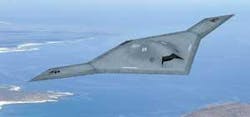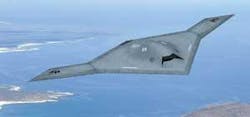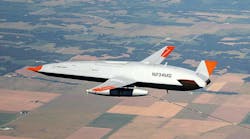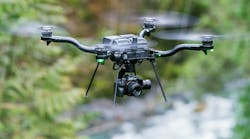By J.R. Wilson
Unmanned Aerial Vehicles (UAVs) first saw combat in the first Persian Gulf War of 1991, where Iraqi soldiers surrendered to a Pioneer UAV rather than have it direct ship-launched cruise missiles on their location. UAVs entered a new era in the second Persian Gulf War of 2003, as more advanced Predator UAVs, armed with Hellfire missiles, became the first robots to engage in combat as aggressors.
The future of continued U.S. air superiority will involve an increasingly large contingent of armed UAVs and a new generation of Air Force and Navy unmanned combat aerial vehicles (UCAVs), flying missions that manned attack aircraft previously flew, often in joint missions under the control of fighter-bomber pilots.
The common job description given for these aircraft is the “dull, dirty, and dangerous” missions, in which an unmanned sensor or weapons platform can do a job that otherwise would require risking a human pilot and far more expensive manned aircraft. In application, however, the future deployment of UAVs and UCAVs is a far more complex balance of not only cost and safety, but also numbers, availability, versatility, persistence and the continued use of advanced technology to maintain the edge required to ensure U.S. air superiority against any potential adversary.
Some of the greatest strengths brought to the fight by unmanned platforms, however, also can be their greatest weaknesses.
“It’s not the specific nature of the lethal aspect that is driving the system so much as designing the system to operate in the adversary’s backyard-a very dangerous environment that it not only must pass through, but persist there,” says Dr. Michael S. Francis, director of the Joint Unmanned Combat Air Systems Office at the Defense Advanced Research Projects Agency (DARPA) in Arlington, Va.
“That creates a very interesting challenge, especially in determining whether the mission is ISR (Intelligence, Surveillance & Reconnaissance) or lethal,” Francis says. “As much as we are trying to make our communications assured, it is another form of Achilles heel. It is much easier to operate in your own airspace, where in the other guy’s, he may deny you the level of communication you need to authorize, in a timely way, the ability to deal with a particular target.
“The danger to the vehicle is driving design more than anything,” Francis continues. “It has a niche where manned aircraft have a difficult time; it is much easier to consider putting a machine in there, but now you have to compensate for not having an onboard pilot making decisions. That is mitigated by having a remote pilot as well as trusted autonomy onboard, which is what the rest of the system is all about. When you are not in contact, it must obey your rules of engagement and perform according to concepts you have laid out, and in doing that it is not predictable to the enemy.”
While the Air Force and Navy UAVs have gotten most of the public attention, unmanned aircraft also are playing an increasing role as a vital asset for ground forces, as the Army and U.S. Marine Corps demonstrated in Iraq, Afghanistan, and elsewhere in Southwest Asia. That has closely followed the Army’s UAV Roadmap 2003 mission designation of reconnaissance, surveillance, and target acquisition (RSTA) for the current UAV platforms, but looking toward an emerging generation of advanced reconnaissance and attack UAVs distributed across several echelons, including some flying missions in tandem with Army helicopters.
Although only two of the four UAVs in the current Army inventory can carry weapons, the unarmed craft are being applied to the battlefield from the traditional ground perspective of artillery and the forward air controller. The laser-designated Viper Strike missile is mounted on the Inet, which can also carry the large-warhead Hellfire missiles, and the Hunter UAVs. Considerable effort has gone into using the latter to refine tactics, techniques, and procedures, blast effects, kill probability, and other capability issues against both stationary and moving targets. In America’s most recent combat environments that has included increasing consideration to collateral damage and post-attack events.
The infantry’s other two UAVs-the Shadow and the hand-launched Raven-have become integral to target identification and damage assessment, with the 4.5-pound, yard-long Raven also playing a significant role in the battle against the Improvised Explosive Devices (IEDs) that have plagued U.S. and coalition forces in Iraq.
“We are working to add a laser pointer and capability to the Shadow, so you could lase with a unit laser right in the middle of a fight,” notes Col. John Burke, the Army’s UAV Systems Project Manager at Redstone Arsenal, Ala. “With terrain familiarity, map overlays and the old artillery designations can be used with the Raven to check out the grid and call in air strikes. So at present we have the Hunter with weapons, Inet with weapons capable, and Shadow and Raven for surveillance and targeting.
“The Extended Range Multipurpose (ERM) UAV that will replace the Hunter will carry any number of munitions, from Viper to Hellfire and even Joint Common Missile,” Burke continues. “The ERM can be weaponized in addition to ISR and communications relay duties, so you can have heavy weapons and heavy sensors. The field commander can configure it any way he wants, from sensors to weapons to communications relay, or a combination; it also can self-designate with onboard laser designation.”
As the increasingly high-tech Army moves closer to deploying lightweight Future Combat System (FCS) by decade’s end, Army leaders also are refocusing on the individual soldier as the centerpiece of 21st-century ground combat, where UAVs-including micro-air vehicles (MAVs)-are becoming an important part of the dismounted infantryman’s arsenal. While MAVs are seen first as vital to a robust, network-centric command, control, communications, computers, intelligence, surveillance and reconnaissance (C4ISR) capability for the FCS battalion, lessons learned in Afghanistan and Iraq have significantly enhanced the UAV’s green-suit role.
The ability of small UAVs to provide a stealthy eyes-forward capability for the Army, Marines, and U.S. Special Operations Command (SOCOM) forces-as well as the Air Force and Navy-has elevated them from interesting oddity to an increasingly urgent requirement down to the squad level. From MAVs that will fit in the palm of your hand to high-flying, long-endurance vehicles the size of Global Hawk, UAVs increasingly will become the platform of choice for new classes of weapons as well as enhanced sensors, such as an advanced (and miniaturized) synthetic aperture radar/ground moving target indicator (SAR/MTI), optoelectronic/infrared and tactical signals intelligence.
Lt. Col. Mike Stroud, deputy commander of the Air Force UAV Battle Lab at Indian Springs Air Force Auxiliary Field near Las Vegas, indicates UAVs may even be integral to combating one of the most deadly aspects of combat-the “fog of war.” Throughout history, precise-location has been a casualty of, and key to, any military engagement, whether at sea, on land, or in the air.
“Rather than the old days of getting good triangulation, I can get a near instantaneous fix on where something is by having multiple UAVs picking up and identifying a threat through any means at hand,” Stroud says. “With good GPS accuracy and them being able to communicate, I can get that triangulation. If I have a swarm of UAVs over the battlefield, they can cover a larger area; and if something comes up very quickly, I can pick it up on multiple UAVs and thus get a more accurate fix.”
New evolutions in technology also will see the further development of a new breed of hunter/killer UAVs, with greater speed, range, and endurance than Predator; DARPA and the Air Force Research Lab are investigating the application of aeromorphing, or an aerostructure that becomes a flat airfoil when the aircraft is loitering on station, and converts to a swept wing for speed and responsiveness when the aircraft is on the move.
“We want to use new technology to sort of accordion the wing out or fold it in, so in one platform, with changed configuration, you can sprint to the scene, then hang out,” says Air Force Col. Michael B. Leahy Jr., material group director at AFRL’s Air Vehicles Directorate. “We’re also looking for more survivable designs for the inlets and exhaust. Then you have a true hunter/killer that can go fast (0.8 Mach) and have long endurance.
“Predator B will carry more munitions and go faster, but it is still a Predator A on steroids,” Leahy says. “Think instead of a new shape, get rid of the tail, carry the ordnance internally; probably between the Predator A and X45-A in size-something less than 20,000 pounds gross take-off weight. An X45-A is designed to fly high transonic, but has no endurance; the Predator flies much slower, but has a lot of endurance. We need a single platform that combines to accommodate the War on Terrorism missions Predator A and B are now used for and give the commander in the field responsiveness and persistence.”
Indian Springs is already home to three UAV squadrons and moving quickly toward full Air Force station or base status as additional units stand up, making it potentially the headquarters for all military UAV operations. At Indian Springs the Battle Lab even foresees UAVs acquiring a new title: tank killer.
“Our primary focus is to go to the warfighters, find out what their problems are, see where UAVs have the ability to solve those, create a concept of operations around that, demonstrate to see if it is successful, then transition it,” says Col. Larry Felder, the Battle Lab commander, citing the lab’s recent Sentry Blu initiative as an example. Officials of the U.S. Air Force Special Operations command (AFSOC) have a problem, he says, part of which is they need a small UAV with a track vehicle-killing capability.
“That didn’t exist when we got the call,” Felder says. “We were able to tie a Sentry UAV-which has a 12-foot wingspan-to a BLU 108, one of the four elements of a sensor-fuse weapon. We tied a 14-inch lug rack (common to AF fighter/bombers) to the UAV and demonstrated how that UAV could kill six tanks. That essentially solves their small UAV problem. Now that concept and options available are being put into the SOCOM requirement. That doesn’t mean they will necessarily buy that particular aircraft, but it does demonstrate they can weaponize small UAVs.
“Our primary focus is existing technology we can connect to an existing UAV, as driven by the needs of the warfighter. If that need has no system that will support a solution, then we will look for a design that would make it work,” Felder says. “As computing power increases, the size of UAVs will become smaller; the day will come when you can put that capability into urban canyons to direct fire. And the next generation of gunship will be a blending of UAV and gunship, providing the gunship with an ISR perspective of the battlespace. The UAVs will actually launch from the gunship, having been carried internally.”
Felder warns against trying to hang too much on UAVs, however, saying they “are a tool, but not necessarily the tool,” whether the requirement is C4ISR or killing tanks. Still, he notes UAVs also offer a potential benefit to the other side of warfare-diplomacy.
“UAVs provide the ability to go into politically sensitive areas where you don’t want to lose a manned aircraft and there is a possibility that can happen,” he notes. “If they take down a UAV, the political consequences are much less. So our commanders and political leadership have much more flexibility.”
That flexibility also may extend to the military’s increasingly joint-and perhaps coalition-battlespace operations, he adds: “I’m hearing rumblings about how to tie ground, sea and air UAVs together, although that has not come to me officially. But there is a lot of synergy on how to tie all these together, regardless of who the warfighter may be. Tying air and ground elements in a network centric way was probably one of the most powerful lessons coming out of Operation Iraqi Freedom.”




